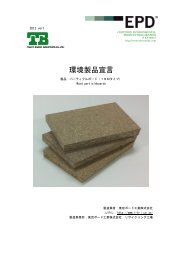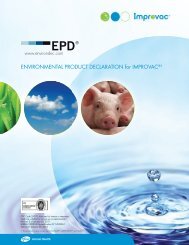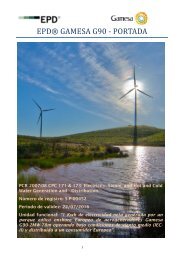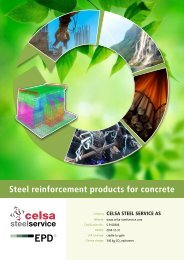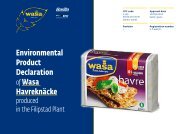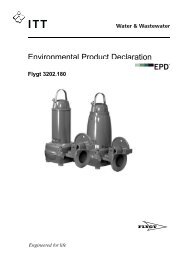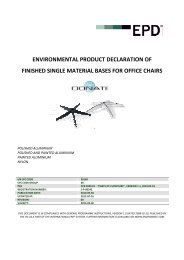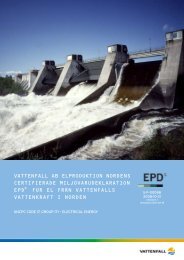Steel reinforcement products for concrete - The International EPD ...
Steel reinforcement products for concrete - The International EPD ...
Steel reinforcement products for concrete - The International EPD ...
Create successful ePaper yourself
Turn your PDF publications into a flip-book with our unique Google optimized e-Paper software.
<strong>Steel</strong> <strong>rein<strong>for</strong>cement</strong> <strong>products</strong> <strong>for</strong> <strong>concrete</strong><br />
Company<br />
Website:<br />
Certification No:<br />
Celsa <strong>Steel</strong> service OY<br />
www.celsa-steelservice.com<br />
S-P-00307<br />
Validity: 2014-12-31<br />
LCA coverage: cradle-to-gate<br />
Climate change: 390 kg CO 2<br />
eq/tonnes<br />
Celsa <strong>Steel</strong> Service – <strong>EPD</strong> – FIN<br />
1
1&2 3<br />
1.<br />
4<br />
2.<br />
Business areas<br />
Customer value through whole chain<br />
Engineering<br />
Celsa <strong>Steel</strong> Service is the provider of <strong>rein<strong>for</strong>cement</strong> solutions<br />
<strong>for</strong> all types <strong>concrete</strong> constructions in the Nordics<br />
Fabrication<br />
Logistics<br />
Accurate<br />
Specifications<br />
Finding<br />
Solutions<br />
Unlimited<br />
Possibilities<br />
Customized<br />
Deliveries<br />
1.<br />
2.<br />
3.<br />
4.<br />
ABOUT CELSA STEEL SERVICE<br />
Celsa <strong>Steel</strong> Service manufactures and sells rein<strong>for</strong>cing <strong>products</strong><br />
and services to the Finnish <strong>concrete</strong> construction industry. <strong>The</strong><br />
production sites in Åminne<strong>for</strong>s and Espo are situated close by the<br />
most active and populated construction areas in Norway, minimizing<br />
transportation distances.<br />
Celsa <strong>Steel</strong> Service has the expertise to provide advice and<br />
assistance <strong>for</strong> the <strong>rein<strong>for</strong>cement</strong> of <strong>concrete</strong> and offers <strong>products</strong><br />
and services that serve to reduce workplace execution times<br />
through efficient planning and adequate logistic solutions.<br />
Celsa <strong>Steel</strong> Service is the largest manufacturer of <strong>concrete</strong> rein<strong>for</strong>cing<br />
<strong>products</strong> in Finland. Products range from cut and bend,<br />
mesh, BAMTEC ® , to an extensive production of prefabricated <strong>rein<strong>for</strong>cement</strong><br />
elements (special welded <strong>products</strong>).<br />
Celsa <strong>Steel</strong> Service – <strong>EPD</strong> – FIN<br />
2
ABOUT THE <strong>EPD</strong><br />
This Environmental Product Declaration (<strong>EPD</strong>) contains the real<br />
facts from a Life Cycle Assessment (LCA) and provides in<strong>for</strong>mation<br />
that can be used in order to put into perspective different<br />
steel sourcing. For Celsa <strong>Steel</strong> Service the <strong>EPD</strong> is a document that,<br />
together with the environmental report from Celsa Armeringsstål,<br />
shows a company investing in technology and technical solutions<br />
that affects the total environmental impact of its <strong>products</strong>.<br />
Celsa <strong>Steel</strong> Service AB is certified according to ISO 14001, and<br />
works <strong>for</strong> a sustainable development of the environment. This<br />
dedication motivates a quest to minimize material and energy<br />
use, but also to seek possibilities to increase the efficiency and reduce<br />
heavy work and unhealthy environments <strong>for</strong> people working<br />
with <strong>rein<strong>for</strong>cement</strong>. <strong>The</strong> company, as a part of CELSA Group,<br />
has the safety as the first priority and the company has incorporated<br />
safety in all its daily activities.<br />
For the <strong>products</strong> delivered by Celsa <strong>Steel</strong> Service, the upstream<br />
processes that include the scrap processing and the steel<br />
works is the dominating emitter. Apart from the upstream processes,<br />
the environmental burden is dependent on transportation<br />
distances, efficient logistics, the level of prefabrication<br />
with minimum material use, and efficient installation at the<br />
construction site. Construction sites have the potential to be<br />
more sustainable by limiting the number transports, handle materials<br />
more efficiently, and implement routines to reduce wastes.<br />
Material <strong>for</strong> the production of <strong>rein<strong>for</strong>cement</strong> steel comes from<br />
the group’s steel and rolling mill in Mo i Rana, Norway. Celsa Nordic<br />
has during many years invested in new technology, not only to<br />
con<strong>for</strong>m to, but to exceed environmental demands in Norwegian<br />
legislation. All these investments have together a major impact<br />
in the production of more environmentally friendly <strong>rein<strong>for</strong>cement</strong><br />
steels in all stages of the production; i.e. the steel mill,<br />
the rolling mill, and transportation.<br />
Environmental benefits also come from the location of the mill<br />
in northern Norway. <strong>The</strong> use of hydropower reduces indirect emissions<br />
and the water used in the processes is naturally sourced<br />
from immediate surrounding water magazines without any energy<br />
input <strong>for</strong> retrieving it. <strong>The</strong> water is available in the processes<br />
but is also generating electricity in the industrial park be<strong>for</strong>e<br />
reaching sea level.<br />
Celsa Nordic has been an environmental pioneer in Norway by:<br />
• Producing its first environmental report according to NS-EN<br />
ISO 14001 already in 1996<br />
• Becoming one of the first mills in Europe to get the EMAS mark<br />
in 2010.<br />
• A 100 % scrap based production, being the largest recycling<br />
company in Norway.<br />
• Reducing mercury emissions as well as primary and secondary<br />
dust emissions, recognized by the Norwegian Climate and<br />
Pollution Agency (Klif).<br />
“We take into account the environmental,<br />
social and economic consequences of the strategic<br />
decisions we make in all our daily tasks”<br />
Celsa <strong>Steel</strong> Service – <strong>EPD</strong> – FIN<br />
3
PROCESS flow<br />
Shipping<br />
Scrap<br />
Melting<br />
Refining<br />
Casting<br />
Rolling<br />
Finished <strong>products</strong><br />
Transport<br />
Fabrication<br />
PRODUCTS<br />
Celsa <strong>Steel</strong> Service works in close relationship with its customers<br />
with the detailing, fabrication and deliveries of <strong>rein<strong>for</strong>cement</strong>.<br />
<strong>The</strong> production involves cutting, bending, and welding of custommade<br />
<strong>rein<strong>for</strong>cement</strong> <strong>products</strong> <strong>for</strong> all types of <strong>concrete</strong> constructions.<br />
<strong>The</strong> <strong>EPD</strong> considers <strong>rein<strong>for</strong>cement</strong> steel made out of hot rolled<br />
<strong>products</strong>, trans<strong>for</strong>med into straight ribbed bars, cut and bend,<br />
mesh, and combinations of these (special welded <strong>products</strong>).<br />
Declared unit; 1 metric tonne of average <strong>rein<strong>for</strong>cement</strong><br />
product at the factory gate in Finland<br />
Scrap transport to the steel works in Mo i Rana production<br />
of low-alloyed steel from scrap and additional alloying<br />
metals in an electric arc furnace hot rolling transport<br />
to a factory <strong>for</strong> <strong>rein<strong>for</strong>cement</strong> <strong>products</strong> in Finland work up<br />
to <strong>rein<strong>for</strong>cement</strong> <strong>products</strong>.<br />
Material Standards<br />
SFS1267:2008, SFS1215:1996, SFS1216:1998 ja SFS-EN 10080:2005<br />
MO I RANA<br />
TROMSÖ<br />
Celsa <strong>Steel</strong> Service production sites<br />
Product certificates<br />
Inspecta sertificat NO. 4380-07, 4470-05 and 5963-01<br />
Other certifications<br />
Celsa <strong>Steel</strong> Service OY; ISO 9001, ISO 14001<br />
Supplier Celsa Armeringsstål AS; OSHAS 18001,<br />
ISO 14001, EMAS<br />
Material characteristics<br />
Hot rolled ductile weldable <strong>rein<strong>for</strong>cement</strong><br />
steel grades 500 and 700 MPa<br />
Product content weight %<br />
Iron 98–99<br />
Carbon 0,05–0,2<br />
Manganese 0,3–0,7<br />
Silicon 0,2<br />
ÅLESUND<br />
TRONDHEIM<br />
BERGEN<br />
DRAMMEN<br />
OSLO<br />
PORSGRUNN<br />
KRISTIANSAND<br />
VÄSTERÅS<br />
VÄNNÄS<br />
ÅMINNEFORS<br />
ESPOO<br />
Packaging materials kg/tonne<br />
Wood, cardboard, plastic 0,25<br />
OLSTYKKE<br />
HALMSTAD<br />
Celsa <strong>Steel</strong> Service – <strong>EPD</strong> – FIN<br />
4
Scrap is transported to Mo i Rana by vessels and the final <strong>products</strong><br />
are delivered to Celsa <strong>Steel</strong> Service by the returning vessels<br />
ENVIRONMENTAL PERFORMANCE-RELATED IMFORMATION<br />
For the purpose of the <strong>EPD</strong> the production chain is subdivided as shown in the figure<br />
Upstream processes<br />
Transport<br />
to the<br />
core process<br />
Emissions<br />
Core processes<br />
Emissions from the process<br />
System boundary<br />
Supply of fuel<br />
Heat generation on site<br />
Supply of external heat<br />
Supply of electricity<br />
<strong>Steel</strong> works<br />
Supply of commodities<br />
Transport<br />
Transport<br />
Production<br />
of 1 tonne<br />
of average<br />
<strong>rein<strong>for</strong>cement</strong><br />
product<br />
from steel<br />
Transport<br />
Transport – Waste to incineration<br />
Product<br />
ready <strong>for</strong><br />
delivery<br />
Waste to<br />
recovery<br />
Waste<br />
incineration<br />
Celsa <strong>Steel</strong> Service – <strong>EPD</strong> – FIN<br />
5
Climate change:<br />
Electricity useage in the processes<br />
- Electricity mix in steel process consists of<br />
hydro power (99,8%) and wind power (0,2%)<br />
390 kg CO 2<br />
ENVIRONMENTAL PERFORMANCE DECLARATION*<br />
Declared unit; 1 tonne of average<br />
<strong>rein<strong>for</strong>cement</strong> product in Finland<br />
Unit/tonne<br />
Upstream<br />
processes<br />
Transports to the<br />
core process<br />
Core<br />
process<br />
eq / tonnes<br />
11%<br />
Total<br />
Impact category result<br />
1 Climate change kg CO 2<br />
eq. 330 46 11 390<br />
2 Acidification kg SO 2<br />
eq. 1.0 0.49 0.011 1.5<br />
3-<br />
89%<br />
3 Eutrophication kg PO 4<br />
eq. 0.16 0.11 0.001 0.27<br />
4 Stratospheric ozone depletion kg CFC-11 eq. 1.6 ∙ 10 -5 5.3 ∙ 10 -6 1.4 ∙ 10 -8 2.1 ∙ 10 -5<br />
Sähkön käyttö prosesseissa<br />
5 Ground level photochemical ozone kg C 2<br />
H 4<br />
eq. 0.13<br />
- Electricity mix in steel<br />
0.06<br />
process consists of<br />
7.3 ∙ 10 -4 0.19<br />
hydro power (99,8%) and wind power (0,2%)<br />
(including impact from NO x<br />
)<br />
Core process<br />
Site specific impact category result<br />
Electricity useage in the processes<br />
Inventory result, energy resource consumption<br />
- Electricity mix in steel process consists of<br />
hydro power (99,8%) and wind power (0,2%)<br />
Electricity use by the core process MJ 158<br />
Electricity use by the steel process MJ 2420<br />
6%<br />
Upstream processes<br />
(steel works)<br />
*<strong>EPD</strong>s from different programmes may not be comparable<br />
11%<br />
94%<br />
0,2%<br />
89%<br />
Sähkön käyttö prosesseissa<br />
- Electricity mix in steel process consists of<br />
Electricity hydro power usage (99,8%) and in wind the power processes<br />
(0,2%)<br />
6%<br />
Ydinprosessi<br />
Ylävirtaprosessit<br />
(teräksen valmistus)<br />
Electricity mix <strong>for</strong><br />
the steel works<br />
99,8%<br />
0,2%<br />
Core process<br />
Wind 0,2%<br />
Upstream processes<br />
(steel works)<br />
94%<br />
99,8%<br />
Hydro Power 99,8%<br />
Tuulivoima 0,2%<br />
0,2%<br />
Ydinprosessi<br />
Vesivoima 98,8%<br />
Ylävirtaprosessit<br />
(teräksen valmistus)<br />
Dominance Analysis<br />
5<br />
99,8%<br />
4<br />
Wind 0,2%<br />
Hydro Power 99,8%<br />
1<br />
Climate change<br />
Acidification<br />
3 Eutrophication<br />
Stratospheric ozone depletion<br />
Ground level photochemical ozone<br />
2<br />
85%<br />
0,2%<br />
66%<br />
<strong>Steel</strong> works Transport Core process<br />
12%<br />
33%<br />
59%<br />
41%<br />
75%<br />
25%<br />
68%<br />
32%<br />
0 20 40 60 80 100<br />
99,8%<br />
Tuulivoima 0,2%<br />
Celsa <strong>Steel</strong> Service – <strong>EPD</strong> – FIN<br />
6
<strong>The</strong> supplier Celsa Armeringsstål is the largest recycling company in Norway<br />
USE OF RESOURCES<br />
<strong>The</strong> result on resource handling covering the production stage (cradle-to-gate), i.e. from resource extraction to the manufactured product<br />
ready to be delivered from the factory, is given below.<br />
Non-renewable resources<br />
Unit/tonne<br />
Upstream<br />
processes<br />
Transports to the<br />
core process<br />
Core<br />
processes Total<br />
Non-renewable energy resources<br />
Crude oil MJ 1360 610 1.6 1970<br />
Coal + lignite MJ 962 10.7 0.030 973<br />
Natural gas MJ 325 31.1 0.084 356<br />
Uranium, natural MJ 216 10.7 0.029 227<br />
Peat MJ 29 29<br />
Additional fuels<br />
(Carbon monoxide and waste to district heating)<br />
MJ 567 567<br />
Renewable resources<br />
Unit/tonne<br />
Upstream<br />
processes<br />
Transports to the<br />
core process<br />
Core<br />
processes<br />
Renewable energy<br />
resources<br />
Hydropower, potential MJ 3000 1.6 0.0044 3000<br />
Wind, kinetic MJ 7.0 0.27 8.2 ∙ 10 -4 7.3<br />
Biofuels MJ 107 0.45 0.0012 107<br />
Renewable material resources<br />
Carbon dioxide kg 9.7 0.023 6.5 ∙ 10 -5 9.7<br />
Water m3 42.5 0.16 3.7 ∙ 10 -4 42.6<br />
Total<br />
Celsa <strong>Steel</strong> Service – <strong>EPD</strong> – FIN<br />
7
OTHER INDICATORS<br />
Unit/tonne<br />
Upstream<br />
processes<br />
Transports to the<br />
core process<br />
Core<br />
processes<br />
External steel scrap charged kg 1174 1174<br />
By-<strong>products</strong> (no allocation)<br />
Slags kg 153 153<br />
Zinc-containing dust kg 15.6 15.6<br />
<strong>Steel</strong> scrap kg 22.1 22.1<br />
Mill scales kg 15.5 15.5<br />
Total<br />
Wastes<br />
Waste <strong>for</strong> recycling kg 0.47 0.095 0.57<br />
Waste <strong>for</strong> incineration kg 0.26 0.011 0.27<br />
Deposited waste kg 22 22<br />
Hazardous waste kg 0.19 0.19<br />
Radioactive waste kg 1.0 ∙ 10 -4 1.0 ∙ 10 -4<br />
CATEGORIES OF IMPACT<br />
2 Acidification<br />
a phenomenon whereby atmospheric precipitations have a lowerthan-normal<br />
pH value, which can cause damage to <strong>for</strong>ests and<br />
crops, and to aquatic ecosystems and manufactured items. It is<br />
due to emissions of SO 2<br />
, NO x<br />
and NH 3<br />
, which are there<strong>for</strong>e included<br />
in the Acidification Potential (AP) indicator, expressed as<br />
SO 2<br />
-eq.<br />
4 Ozone depletion<br />
degradation of the stratospheric ozone layer, which blocks the<br />
ultra-violet component of sunlight, by means of highly reactive<br />
compounds originating from chlorofluorocarbons (CFCs) or chlorofluoromethanes<br />
(CFMs). <strong>The</strong> substance used as a reference <strong>for</strong><br />
the ODP (Ozone-Depletion Poten-tial) is trichlorofluoromethane,<br />
or CFC-11.<br />
1 Greenhouse effect<br />
a phenomenon whereby infra-red rays emitted by the earth’s surface<br />
following solar heating are absorbed by molecules present in<br />
the atmosphere and reemitted in the <strong>for</strong>m of heat, causing global<br />
warming of the atmosphere. <strong>The</strong> indicator used here is the GWP<br />
(Global Warming Potential), which covers emissions of carbon dioxide,<br />
the main greenhouse gas, and other gases with a higher<br />
degree of infra-red absorption, such as methane (CH 4<br />
), nitrous<br />
gas (N 2<br />
O) and chlorofluorocarbons (CFCs), which are expressed<br />
as a function of the degree of absorption of CO 2<br />
(g CO 2<br />
).<br />
3 Eutrophication<br />
the enrichment of watercourses with nutrients, which causes imbalances<br />
in aquatic ecosystems due to overdevelopment as the<br />
result of a lack of nutritional limitations. Eutrophication Potential<br />
(EP) mainly covers phosphorous and nitrogen salts, and is expressed<br />
as PO 4<br />
3-<br />
eq.<br />
5 Photochemical ozone creation<br />
the production of compounds which, by the action of light, are<br />
able to promote an oxidation reaction that leads to the production<br />
of ozone in the troposphere. <strong>The</strong> POCP (Photochemical Ozone<br />
Creation Potential) indicator mainly concerns VOCs (Volatile Organic<br />
Compounds) and is expressed as equivalent weight of ethylene<br />
(g C 2<br />
H 4<br />
).<br />
Next generations<br />
will bene fit from<br />
today’s responsible<br />
consumption<br />
CO 2<br />
counts<br />
Celsa <strong>Steel</strong> Service – <strong>EPD</strong> – FIN<br />
8
Celsa produces steel with means of renewable<br />
energy by hydro power in Helgeland, Norway<br />
VERIFICATION<br />
Independent verification of the declaration and data,<br />
according to ISO 14025: Lars-Gunnar Lind<strong>for</strong>s, IVL Swedish<br />
Environmental Research Institute.<br />
<strong>EPD</strong> Programme: <strong>The</strong> <strong>International</strong> <strong>EPD</strong>® System<br />
Note: <strong>EPD</strong>s from different programs may not be comparable<br />
Certification No: S-P-00307<br />
Date of publication: 2012-05-30<br />
Validity: 2014-12-31<br />
PCR: Construction <strong>products</strong> and construction services,<br />
version 1.0, 2012-01-19<br />
PCR review conducted by: <strong>The</strong> technical committee of<br />
the <strong>International</strong> <strong>EPD</strong>® System<br />
For more in<strong>for</strong>mation: www.environdec.com<br />
Company<br />
Contact person <strong>EPD</strong>:<br />
Celsa <strong>Steel</strong> service OY<br />
Address Jokitie 35<br />
10410 Åminne<strong>for</strong>s<br />
Phone: +35819-221 31<br />
Website:<br />
Johan Söderqvist,<br />
johan.soderqvist@celsanordic.com<br />
www.celsa-steelservice.com<br />
This environmental declaration is prepared by Mats Almemark, November 2011 IVL Swedish Environmental Research Institute<br />
– independent qualified environmental competence. www.ivl.se +46 8 598 563 00 – mats.almemark@ivl.se<br />
Graphic design: Konkret Affärskommunikation AB. www.konkret.se<br />
Celsa <strong>Steel</strong> Service – <strong>EPD</strong> – FIN<br />
9



